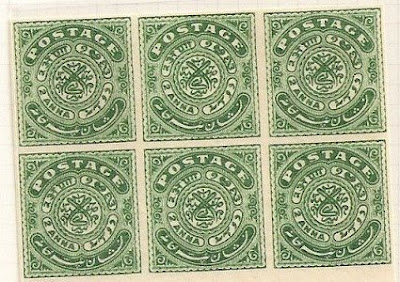Monaco 1891-94 second issue imperforated proof without the figure
of value in the value tablet and printed in black on light buff cardboard
of medium thickness and of a rather silky texture, of obviously very high
quality for that period, ungummed and with good and equal margins all
around, creating a wonderful aspect which is enhanced by the outstanding
quality as well, without any faults or defects whatsoever and truly pristine
in all respects, the sharpness of the impression is absolutely remarkable,
much better than that of the issued stamps and of impressive finesse, from
the aesthetic perspective, this proof is a true work of art in itself, and from
the philatelic point of view it is indeed a very rare item which very rarely
surfaces the market, a great item destined for a knowledgeable philatelist
with an eye for wise investments.
Monegasque philately, although fascinating valuable and most decorative,
is a very straightforward one, with a very limited number of spectacular
varieties or variations from the basic, issued stamps, even during its classic
period. Hence, the undenominated proofs for the second and first issues of
Monaco are most probably amongst the most interesting
(if not “the” most interesting) Monegasque items available, and the vast
majority of the already extremely few existing proofs for the second issue
are printed on normal paper. Those on cardboard, like this one is, are virtually
non-existent and constitute the supreme refinement as far as distinguished
classics of Monaco are cconcerned, and also such proofs are missing from
most collections.
Another such proof for the second issue of Monaco is being currently offered
by the French auctioneers Behr (http://www.behr.fr) in their Net Price Sales
no. 87 for €800 (~ $ 1,040) – lot no. 3075 –
but that is inferior as it is on normal paper.


Monaco 1885 first issue imperforated proof without figures of value in the
value tablets, printed in black on buff cardboard of medium thickness
ungummed and displaying large and well balanced margins all around, the
quality and sharpness of the impression are absolutely outstanding and
to describe this wonderful and immensely rare proof as “perfect” would
probably be an under-statement, not only it has no defects whatsoever
displays vibrant colour and superb freshness as well, a fantastic item,
Monegasque philately, although fascinating valuable and most
decorative, is a very straightforward one, with a very limited number
of spectacular varieties or variations from the basic, issued stamps,
even during its classic period. Hence, the undenominated proofs for
the first and second issues of Monaco are most probably amongst the
most interesting (if not “the” most interesting) Monegasque items
available, and the vast majority of the already extremely few existing
proofs for the first issue are printed on normal paper. Those on cardboard,
like this one is, are virtually non-existent and constitute the supreme
refinement as far as distinguished classics of Monaco are cconcerned, and also
such proofs are missing from most collections.
As reference, the French auctioneers Behr (http://www.behr.fr) are offering
a similar yet inferior proof (as it is on normal paper) in their current Net Price Sale
no. 87 for €4,000 (~ $ 5,200) – lot no. 3047.

Monaco 1885 first issue 1c block of twelve (4 x 3) with complete
gutter margin attached at right and with eight stamps
MNH rarely offered in general and almost never
available this fine, no. 1 in any catalogue, Yvert cat. value as
two blocks of four and four singles,
all hinged, is already €440 (~ $ 575), but this mostly unmounted
block must certainly deserve a huge premium over that value.

GOLD COAST 1904-6 2/6 OPT.
SPECIMEN MINT, SG 57s.

India 25 Rupee Victorian Telegraph Stamp

QV 1879 Perkins Bacon Essay
Ridgway designed 'Perkins, bacon & Co' essay. Imperforate example,
in grey-brown with gum. The 'W' check letter is the initial of the
designer W. Ridgway. Eventual contract was
awarded to de-La-Rue. Scarce item.















































